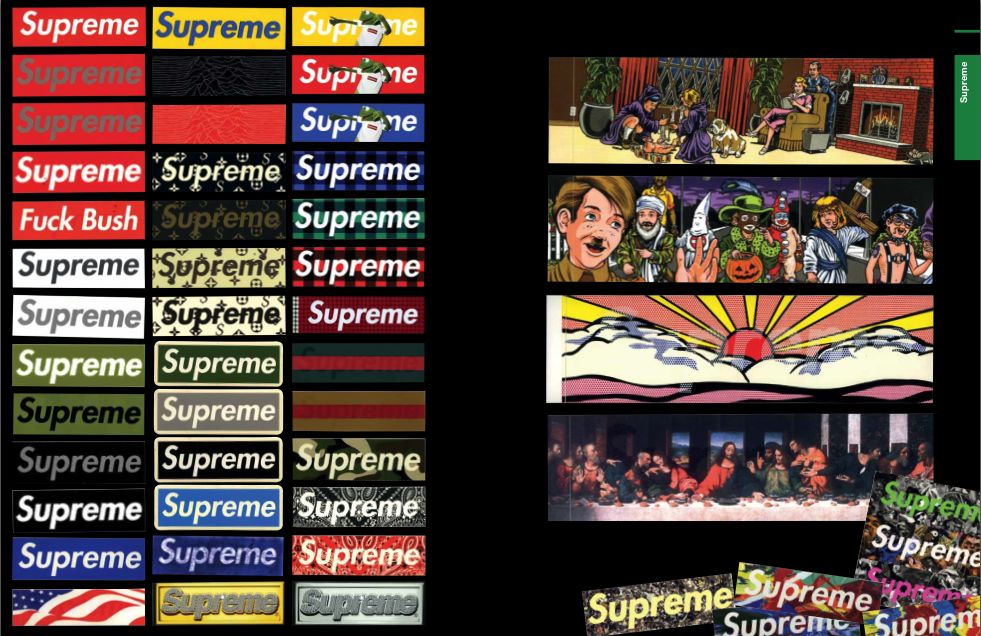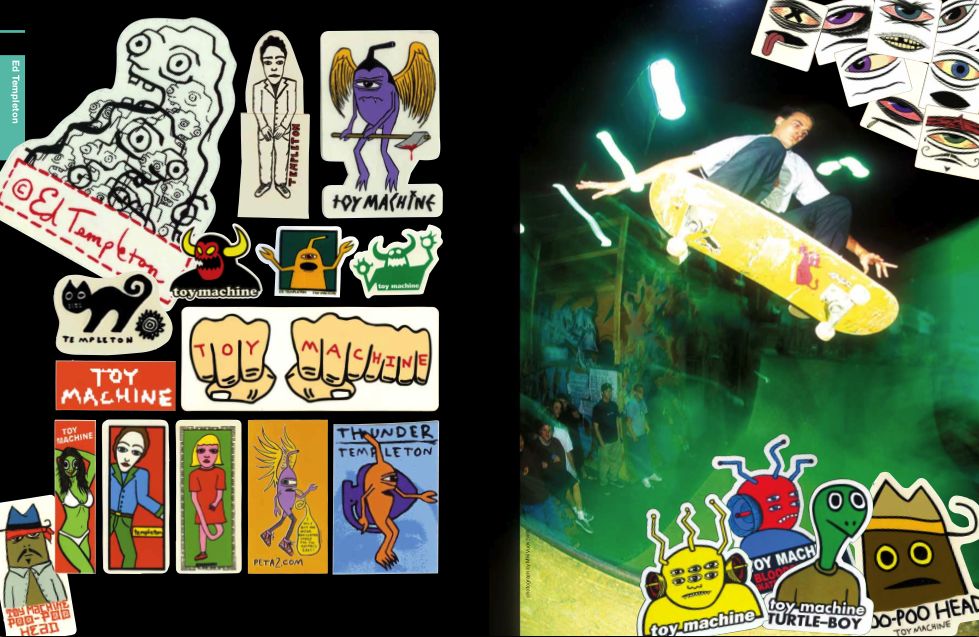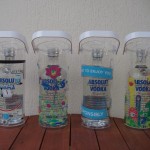Archive for the 'Design' Category
Monday, January 23rd, 2012
Disney Riffs Legendary Saville Design
In our second story of the day involving Disney and cultural appropriation, the world’s largest mouse-based media conglomerate has begun selling a new t-shirt riffing celebrity graphic designer Peter Saville’s now legendary cover art for Joy Division’s 1979 classic, Unknown Pleasures. As Pitchfork aptly notes, “Does Disney know that the singer of this band hung himself?! Do they know where the name “Joy Division” comes from?! Do they know how stupid this guy looks wearing this T-shirt?” Amen…
Friday, December 3rd, 2010
Bright Lyons Grand Opening
I’m in Miami for all the Basel madness and am sad to be missing this back home. If you are in NY tonight, stop by the grand opening of Bright Lyons, a new store in Brooklyn mixing modern furniture and design with a contemporary art gallery. The shop is run by our Paul Bright, who’s previous endeavors included an old favorite of ours, Community Outreach/Paul Bright Gallery in Toronto and Hamilton, Cananda
Tuesday, October 5th, 2010
Peel Slowly and Read:: TAC Speaks with DB Burkeman about his new book
This week Rizzoli releases Stickers: Stuck Up Piece of Crap – From Punk Rock to Contemporary Art. The publication is a massive chronicling of the history of sticker culture, with more than 4,000 images and 30 contributing writers including Martha Cooper, Stanley Donwood, Shepard Fairey, Carlo McCormick, Clayton Patterson, Stephen Powers(ESPO) and Swoon. I got together with the book’s creator, my close friend DB Burkeman, to geek out about art, music, pop culture, and things to come.
JN: A lot of people know you from your pioneering contributions to Drum and Bass and involvement in the music world, but we first met down in Miami during Art Basel and hit it off geeking out over art together. I remember being excited to meet another musician who was finding himself more and more obsessed with contemporary art. When did you start paying attention to art. Was music your entry point?
DB: I was psyched to meet you too. You were my first real art geek friend! For me, music and visual art have always been totally connected. I even feel that they are really just different expressions of a similar process. As a nerdy kid I spent many hours lost in the gatefold sleeves of new albums by my favorite bands. It was as important to the ritual and enjoyment process as listening to the record. I think I actually wanted to be an artist, before I wanted to be a DJ, but not being able to draw for shit kind of hindered that option. I wanted to be a rock star too, but couldn’t play an instrument well either. So I went for taking pictures of rock stars instead. Then I heard a DJ that gave me an epiphany. When I was putting out mix-tapes and mix CD’s I always paid super attention to how they looked. I’m always shocked when someone puts out a great record that looks like poo. I really hated the creation and take over of the CD format. That real estate of the twelve-inch was reduced to a measly five-inch cover with nasty plastic. As for MP3’s, yeah, great for mobility, but no visual presence at all. I’m sure you and your readers are aware of the massive revival of vinyl. I was talking to someone from ADA (Alternative Distribution Alliance) last week and he said that pretty much every indie band releases their albums in a vinyl format now.
JN: Music was the catalyst for me too. High school was the first time I can recall wanting to find out about who the certain artists were behind art. I needed to know everything about a record – from the studio it was recorded in and who was at the mixing board, to who was behind the imagery. I really love the section in your book with old SST Records stickers from bands like Black Flag, Meat Puppets and Husker Du. Indie labels like that were definitely the first art I paid attention to. Sonic Youth was another big one for me. The records they did with artists like Raymond Pettibon, Richard Kern and Mike Mills became the first artists I started to follow and look in to.
DB: Well, I’m older than you. I wanted to know about who did Led Zep covers and go work for them. I actually applied for a job too. Hypgnosis wrote back and said I needed a university degree. Then I discovered Punk Rock. I think I forgot to tell you, but hanging out with you was what gave me the idea and then inspiration to try to get Sonic Youth in the book.
JN: No, You never told me that. That’s awesome! They recently put out a book and did an exhibition chronicling all their collaborations with visual artists.
DB: Do you know about Vinyl Factory in London? Its a art based record company that makes limited editions of big name artist records. You should see the Massive Attack one they produced – incredible!
JN: I think maybe we were looking at that shopping for records at Kim’s and started taking about the Designers Republic stuff too. Can you talk about the genesis of the book? I think when I met you two years ago it was in your head and you had already started contacting contributors.
DB: It started just over 3 years ago, simply as me trying to gather together all the stickers I’d collected from punk and then skate and street brands into a scrap book. A friend actually suggested that it might make an interesting book as a history of stickers. I did a bit of research and found there were loads of sticker books in the market, mostly graf and street art ones, but nothing that came at the subject from a historic, timeline perspective.
JN: One of the things that interested me about this book is that even though it’s represented, this is not really about graffiti, but functions more as visual history of how stickers have existed and evolved over time within different segments of the pop culture landscape, including music, fashion, the street.
DB: I think the graf and street art angle was why the publishers were all hungry for it, but its definitely not a graffiti book. Anyway, by the time I’d met you I was in way over my head. I had collected thousands of stickers and people from all walks of life offering more, but I had no publisher no designer to actually turn it into a book. I ended up meeting the designer Monica LoCascio via Gary Pini and together we created a few mock pages to send to publishers.
JN: Was it hard approaching potential contributors, especially some of the more notable ones without having a publisher? I imagine some bigger entities or names may have only want to be involved if there was a well known publisher and good distro on the table, and have shied away from doing something smaller or more DIY. How did you tackle that and not come off like, “Hey, I’m making this really great book and I don’t have a publisher and can’t tell you who will put it out, but you should be in it anyway!”
DB: Some people were amazing, I think Radiohead’s visual artist and designer Stanley Donwood wrote back and said he was down to contribute text before I had Rizzoli on board. ESPO and Banksy too. It really took off once I had a prestigious publisher’s name though.
JN: How did Rizzoli get involved?
DB: It sounds crazy, but I simply found the name of an editor. Actually Ryan McGinness kindly gave it to me and I pitched the idea of the book to them. Turned out my now editor at Rizzoli actually had a tag sticker of her own and the book idea instantly connected with her on a personal level. It’s really nuts, because out of the five top publishers I wrote to, four of them came back and made offers.
JN: I’m sure having so much of the leg-work done with contributors already on board, content sorted and legally cleared helped seal the a deal.
DB: I think it helped for sure. The main challenge for me was keeping track of who had given what to me and making sure they were credited. I think my favorite two pages in the book are 289 and 299. They have no stickers them, just a list of 1300 credits! We worked for three months on those two pages. I actually have real nightmares about people coming after me pissed off that I spelled their name wrong or missed the page they are on. There are still hundreds of stickers that are not credited yet. We have a email address, whomadethatsticker@gmail.com, for people to write to so the next printing of the book can be updated.
JN: So you still don’t know who the artists are behind some of the images, but what about the stuff you did know? Was getting the rights to anything a hassle or cause any roadblocks? I know there was that headache with Live Nation and Sex Pistol, right?
DB: Most the real problems with permissions were from companies that owned the rights, not the original artists. The Pistols held a very special place in my heart. I came of age at the exact moment of their creative output. Sadly my feelings have considerably changed towards them. I spent a frustrating year and three months trying to get permission to simply show a few of their stickers. Live Nation owns their rights now. They wanted to know how much I would pay. I really wanted to put together a page that said “Sex Pistols stickers: permission denied by Live Nation,” but Rizzoli shot that down since they are working on the idea of a Pistols’ book. Eventually they were able to clear it for me but only with the stipulation that Jamie Reid was not credited as the artist. Nice people Live Nation are, huh? Since then I’ve noticed a massive flood of Jamie Reid’s images on all manner of cheesy products.
JN: Yea, Live Nation are behind the recent PiL reunion too. Lydon’s in deep! So, looking back, where do you see the earliest seeds of a sticker culture?
DB: It’s really hard to define where and when the culture started. The first sort of craze in America was called Decal-Mania, but travelers in the 1920s would put country or city stickers on their luggage trunks to show off where they had been. Clayton Paterson’s partner, Elsa Rensaa told me this great story about how in the French Revolution the streets of Paris had wheatpastes of Mary Antoinette being fucked by pigs. Rizzoli are such sticklers for fact checking, so I couldn’t include it in my introduction since we could not find exact documentation of it. Carlo McCormick wrote an incredible academic history piece for the one of the three introductory essays in the book.
JN: One of the most interesting aspects of street sticker culture is the riffing and remixing of designs. A well known example is how many people out there have taken Shepard Fairey’s early Andre Has a Posse sticker. And he himself, along with countless others – the Supreme logo for example – have used Barbara Kruger’s red and white block lettering style. You’ve also been a part of this. You’ve referenced both Kruger and Fairey in some of your own stickers. What would you say to those who see this as nothing more than lazy design theft?
DB: Interesting question. I never thought of it as theft. The thing I love most about stickers it is how they show that a simple graphic or design can get into the sub-conscience of society and become part of the visual zeitgeist for the next ten or twenty years. I’ve been a fan of “culture jamming” since I first discovered it in the early 80s via Rick Klotz and his streetwear brand Fresh Jive. Stussy also flipped Channel’s logo with the double S’s instead of C’s. As a club and rave promoter in the early 90s I did my own logo jamming stickers, very influenced by Klotz. But really, it all comes back to the Pop artists of the 60’s like Warhol and Rosenquest with products.
JN: Yeah I don’t look at it that way either – to me its probably the most compelling thing about the culture. There is an ongoing dialogue and acceptable language of appropriation that keeps evolving. What about people who search the streets, remove and collect them. Martha Cooper, for example, recently published her second book of stickers from her personal collection. I know there has been some criticism against people who remove them from their intended home on the street. Where do you weigh in on the debate?
DB: Martha’s essay in our book is titled “Confessions of a sticker thief. ” Call me nieve, but I never considered it stealing. I think of it as collecting them to show them to a wider audience. If I didn’t take it to preserve it, someone else would, or it would get buffed off by the city, or the weather would destroy it. So far no artist has contacted us and said they don’t want to be in the book or in the gallery shows we’re working on. Plus we are offering to give back any of the stickers to the artists that did not donate them. It’s the same email as I mentioned before, whomadethatsticker@gmail.com.
JN: Sounds like you’ve been pretty supported by the community. Any haters?
DB: Only one hater so far. Generally people seem to be going nuts & saying stuff like “It’s the fucking bible of Stickers!” Monica and I worked so hard on this and it’s so amazing to finally see the 30 writing contributors and the 1300 artists that we know of be impressed and pleased. So far the biggest kick I’ve gotten was sitting at Tony Goldman’s desk watching him spend 30 minutes scanning the book and finally saying, “this is an important contribution to art.” Monica and I were walking around in a pink cloud for the rest of the day. Till the next crisis came up.
JN: Nice! He’s gotten fairly involved in in supporting street art. There was the Deitch sponsored Wynwood Walls project he provided space for during Basel Miami and he’s been lending the Houston Street wall in New York out for a couple of years now. Actually, I think every artist that has been on that wall is represented in Stuck Up – Haring, Os Gemeos, Shepard, and now McGee, right?
DB: Sadly I could not get Os Gemeos stickers in time for book, but they will be in the exhibition. I don’t want to say too much about why we were talking to Mr. Goldman for fear of jinxing it, but watch this space!
JN: Got it! So what’s up with the exhibition?
DB: We’re working on finding the right partner and sponsor to help us turn the book into a museum quality exhibition. Not just a bunch of stickers on the walls, but a massive project. The plan is to do New York in March, Chicago in July, L.A. in September, and Miami for Basil in December 2011. Lots of really exciting stuff in the works, but I need to get some sleep first….
Stickers: From Punk Rock to Contemporary Art is out now via Rizzoli in paperback or as a limited, numbered hardcover deluxe boxed edition, including a folder pack of 23 exclusive die-cut stickers, many signed by the artists. Contributors include Kenny Scharf, Barry McGee, Ryan McGinness, Jose Parla, Mark Dean Veca, Rostarr, and Space Invader.
DB can be heard on his eclectic by-weekly mix-tape style radio show, BLURRINGradio at http://urls.artonair.org/blurringradio (shows are achieved down the page).
(All text © Jeff Newman)
Sunday, July 11th, 2010
Absolut ESPO + Aoshima
Absolut Vodka has teamed up with Stephen Powers and Chiho Aoshima for a new promotion called The Absolut Art of Sharing. For the campaign each artist has contributed two designs to a series of four unique drink pitchers. From what we can tell, they’ve been released in various sizes for different markets (1Liter in US, 700ml in Europe/New Zealand, 750ml in Mexico), making it a bit hard and confusing to collect them all if you are that obsessive or that much of a drunk. So far, only 3/4 designs have been released in the 1L and 750ml sizes, so your best bet is to go for the 700ml set, which so far have hit a limited number of specialty stores in the UK, France, Belgium, and Greece. If you are that inclined to figure it all out, check the antics on this Absolut collector’s forum, where we ganked most of these pics from. Oh, and there’s always the easy way – ebay.
Monday, June 14th, 2010
Barbara Kruger Goes Underground
Barbara Kruger has designed the London Underground’s latest pocket map cover. Kruger’s Untitled (Tube Map) depicts part of a standard tube map (the most recognized area of Zone 1) with station names replaced by emotions and other words that evoke feelings for select areas of the city. Piccadilly Circus is Irony, for example. The maps are available now.
Beginning in 2003 with a commission by Emma Kay, the Art on the Underground program has invited an international mix of artists to design covers for the city’s rail system. Past contributors include Richard Long, David Shrigley, Cornelia Parker and Gary Hume.

Richard Long’s 2009 effort, Earth. The six stacked lines symbolize Tube lines and a classical Chinese I Ching hexagram for Earth, with the black grid between them references the city’s Northern line.
Wednesday, June 9th, 2010
Historic Haring Mural in Need of Rescue
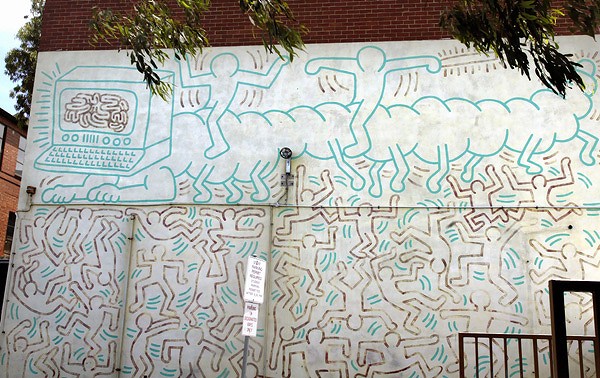
The faded and damaged Haring mural as it looks today. (Image: Andrew De La Rue via Sydney Morning Herald)
The Art Newspaper reports that the last surviving mural Keith Haring painted entirely on his own, and the first project he completed with the assistance of a cherry picker, is in dire need of preservation. Painted in 1984 during Haring’s only visit to Australia, the mural occupies the wall of the former Collingwood Technical College in a Melbourne suburb. Last restored in 1996, the significant work has not been maintained for almost 15 years, and suffers from significant surface lifting and cracking of the paint. Estimates to stabilize the outdoor work are reported at A$25,000 ($22,000 US), with an additional A$1,000 ($900) for annual upkeep.
Several major Australian arts institutions and local municipalities have banned together to raise support for its restoration. “It is our own government who has lapsed in its duty of care,” said one spokesperson, noting that the building is owned by the Victorian State Government and that the mural sits on its heritage registry.
”Yarra’s mayor Jane Garrett said, “The mural is a part of Yarra and inner-Melbourne’s cultural and physical landscape—and we want to ensure it stays that way,” adding that interested parties were in the process of setting up a working group including representatives from the arts community and other interested parties to “discuss the mural’s future and come to a consensus on the most appropriate way to preserve it.”
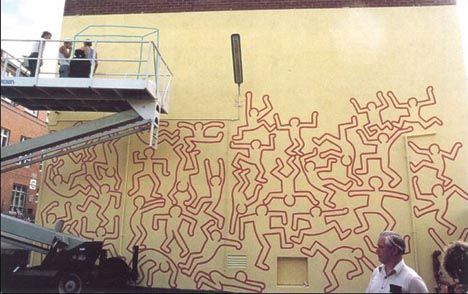
The original mural in progress durning Haring’s 1984 visit to Melbourne (Image via The Art Newspaper)
In more productive news, a new series of Keith Haring adhesive wall graphics (pictured below) has been released by Bilk, with several different designs available from $18 – $55.
Sunday, June 6th, 2010
Condo Covers Kanye

(Photo: Gareth Cattermole/Getty)
After commissioning Takashi Murakami and Kaws for previous releases, Kanye West turns to George Condo for the cover design of his new single, the King Crimson-sampled Power. Of the three, Condo remains largely unknown by West’s younger street blog-savvy audience. Not that that matters much. With a career dating back to the early 80s, the 53 year old Condo is arguably the most established, with his paintings and sculptures residing in the permanent collections of major art institutions,including the Whitney (he participated in both the 1987 and 2010 Biennials), MoMA, and Guggenheim.
A 1995 oil painting by Condo is on view through June 19 at Luhring Augustine (NY), as part of Twenty Five, the gallery’s 25th anniversary group exhibit.
Power (which can be streamed here) is due out on iTunes June 8, with West’s next full length, Good As Job, expected to drop late 2010.
Monday, November 23rd, 2009
Kaws X Kiehls Arrives

(All Images © Jeff Newman/TheArtCollectors)
Check out these new displays featuring KAWS’ designs at Kiehl’s flagship NYC store. As previously reported, the artist and luxury beauty company have teamed up, creating a limited edition moisturizer to benefit Rx Art. While the product is available now in three sizes, you may want to hold off till next week when KAWS gift boxes and shopping bags will be available in store.
100% of net profits will benefit RxArt, a New York based nonprofit which invites well known artists to decorate hospitals and children’s medical centers. No word yet whether KAWS will be creating one of these installations, but his youthful imagery and cartoon references would be perfect fit.
Wednesday, November 18th, 2009
Quickflip :: Hirst Supreme Decks 2.0
Supreme drops the second series of Damien Hirst skateboards in their NY and LA stores tomorrow, Nov. 19. The release includes five separate designs, each incorporating elements from Hirst’s popular Spot Paintings, along with new icons referencing reoccurring themes in his art, such as drugs, death, and religion. Japan sales will take place Nov. 20, followed by online sales on Nov 23.
As with the first Hirst deck release, expect these to disappear instantly, and then reappear quickly on ebay.
Monday, November 2nd, 2009
KAWS lends a hand to Kiehls charity for RxArt
KAWS has teamed up with nonprofit, RxArt, and luxury beauty products company, Kiehls, lending his designs to a limited skin moisturizer. With prices ranging from $26 -$70, you can feel good about indulging in one of the 3 available sizes. 100% of profits will benefit RxArt’s continuing mission of curating installations in hospital settings across the United States. Past projects include works by Donald Baechler, Ryan McGinness, Matthew Ritche and Frank Stella.

Ryan McGinness’ RxArt installation for the NYU Child Study Center. (Image: RxArt)









